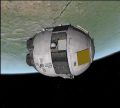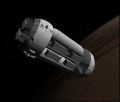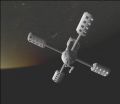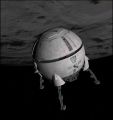World of 2001
|
Project home: World of 2001 homepage, available on Avsim.com or Orbiter-forum/resources |
The World of 2001 is a project to create the spacecraft and spaceports from the movie "2001" and the related novels by Arthur C. Clarke as addons for orbiter. While not all spacecraft or spaceports are mentioned in the movie or a novel, they can be considered logical extensions of the canon spacecraft.
The project is currently maintained by Erik "Sputnik" Anderson, Alain "80MilesHigh" Hosking and Wolfgang "Nautilus" Schwarz. The latest version is 3.1.
Alternative history
A key part of the technological optimism of 2001 is routine, cheap access to space. Clearly, their shuttle program turned out entirely differently from ours.
Here, the success of Apollo in the 1960's was followed by lunar bases and 50-man space stations, both American and Soviet, in the 1970's. These culminated in Mars missions in the early 1980's. All were launched by large expendable launch vehicles; Saturn V, Neptune, and N-1. Development of a reusable shuttle proceeded, but later, by which time we were all a bit smarter and better-looking. Full employment of the Apollo team was not a goal of the shuttle program; they were busy doing other things like going to Mars. This had beneficial effects on a lot of architecture choices, especially the decision to leave shuttle operation to third parties, rather than making it a space-agency monopoly.
Development of the spaceplane proceeded in two stages. The first stage was to develop the orbiter, which would get to orbit by staging a drop tank. The Lockheed Starclipper was taken as a design starting point, though the final configuration of the Orion II/III was different in many details. The Titov V was not; it unabashedly shows its origins as the borrowed Starclipper.
By the end of the 1980's, it became significantly cheaper to launch supplies in small pieces on the shuttles than to launch on Saturns, or even the economy-size Neptunes purchased in bulk. First propellant, and later, as orbital assembly became a going concern, structural elements, were brought up routinely in small daily (and later, hourly) flights rather than big monthly ones. Space stations and moon bases and the Mars base were not abandoned; they were expanded.
The market for shipments to orbit well-established, it was time to bring costs down another increment. The Orion IV and Titov B boosters were developed, and passenger service became cheap enough to be afforded by thousands, then millions. An orbiting hotel was built.
The USSR passed into the hands of pragmatic leaders, communist by name but with capitalist reforms. Ideological competition between the superpowers lessened, though did not end entirely. The two superpowers did cooperate to try to lessen other powers' access to space; this was almost completely unsuccessful. The Chinese built space stations and moon expeditions; the British built a moon base.
Thirty-eight declared nuclear powers flexed their muscles, and for reasons not fully explored or explained, at least six of them placed nuclear weapons in orbit. (By the time of 2010, this was apparently illegal by treaty, but violated anyway. What the advantage is of putting your nukes where it takes longer to use them and anyone can tamper with them, nobody can explain. We're faithful to the canon anyway.)
Today, the drop tank versions continue in service for some missions. While riding a reusable booster is clearly cheaper, boosters are scarce resources, closely scheduled. The drop tank allows missions, particularly military ones, to proceed without tight schedules in advance. It is the ONLY practical way to place a military spaceplane on alert, ready for launch but at an indeterminate time.
History
Changes since 3.0
- Soviet space-to-space craft added – Gagarin moon lander, Komarov inner-system transport, Patsayev tanker, Bondarenko self-deploying space station, Merkur experimental-engine testbed, Skorpion patrol corvette.
- Herculis cargo transport and Draco patrol corvette added.
- Space Station Four and Three added. Station V Early and Complete added. Docking to the centerline port of Stations Four and Five will now cause traffic control to shift you to a side port, freeing up the centerline port for use. Press undock to go back to the centerline port for departure.
- Upper stages (Centaur-O and Titov G) added.
- Orion II/III and Titov autopilot reworked for better flight-path-angle management and a bit more turning ability. Also, throttling issue fixed; no non-intuitive dashing off at max power now.
- Many satellites and payloads added. Landing module added that permits a re-entry and soft landing for ballistically launched Mars cargoes. So that's how the Mars bases were built!
- Attach point handling added – craft can grapple satellites and cargo, making it possible to trans-ship from Earth launch to a deep-space craft to its final destination. Now the Taurus has something to do!
- M-53 Soviet SST added.
- New bases: Aberporth, Brest, Cuxhaven, Hainan. All the major space powers can launch their nuclear weapons into orbit now.
- MANY scenarios added!
Changes since 2.3
- The Sol_2001 environment has been created, containing numerous 2001 bases and locations without fooling with your base sol.CFG environment.
- Lost Worlds of 2001 has been scoured for other solar system installations. In addition to Clavius and Tchalinko, Port Lowell on Mars and Cytherean Station One in orbit about Venus, have been added.
- The Moonbus (and Soviet Rocketbus) has been added.
- The 2001 EVA astronaut has been added.
- The Orion III has been completely re-meshed and re-coded. Now includes moving control surfaces, opening door, landing gear. Also includes Orion II cargo model, Orion I drop tank, and Orion IV booster stage.
- The Soviet Titov V spaceplane has been added, with capabilities analogous to the Orion.
- Kulch's steam catapult added at Canaveral and Baikonur to launch the spaceplanes as described in the book (horizontally).
- Aries Ib completely re-meshed and re-coded. New variants on the Aries are included – cargo variant, Mars variants, the Taurus orbital tug, and the Aquarius interplanetary transport. Aries is now a tailsitter
- The satellites seen in the first space scenes of the film have been added, to give those cargo spaceplanes something to put in orbit.
- The Boeing 2707 SST has been added, to fly Floyd on the first leg of his journey. Floyd's Journey scenarios extensively reworked.
Gallery
A Rocketbus over Soviet Tchalinko base
Merkur docked to Cytherean Station One over Venus
Weblinks
- World of 2001 homepage
- World of 2001 v3.11 2011-09-25 at Orbiter-forum/resources.
| The World of 2001 |
|---|
|
Spacecraft: Aquarius | Aquarius Id | Aries | Bondarenko | Centaur-O | Draco | Gagarin | Herculis | Komarov | Komarov-bis | Merkur | Moonbus | Orion | Patsayev | Polaris 1-XE | Rocketbus | Skorpion | Taurus | Titov V | Titov G Space stations: Cytherean Station One | Space Station III | Space Station IV | Space Station V Surface bases: Aberporth | Baikonur | Brest | Canberra | Cape Canaveral | Clavius Base | Cuxhaven | Hainan | Kadena AB | Korolevgrad | Lunar Observatory | Moscow | Phobos Base | Port Lowell | Prime Base | Serenitatis Base | Tchalinko | Tranquility Museum | Tycho | Washington |























